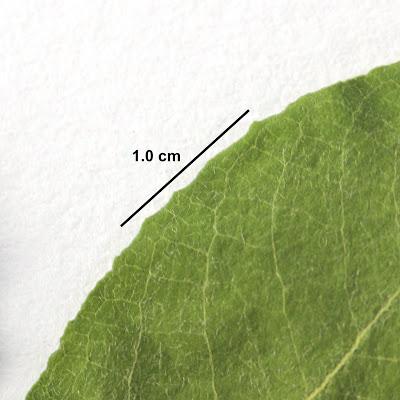
“less than 10 teeth per cm on leaf margins mid-leaf”
Another month has passed. I do think they go by faster and faster, as I was told they would. Already tree-followers are gathering to share stories and photos about their chosen trees, as they do every month.But I’ve been away, and two months have passed since I last reported on my willow. It bloomed early – catkins were emerging by the end of February. When I left town in late April, it was in full bloom. But there were no leaves, and its identity remained a mystery.One needs leaves to identify most willows, and even then it isn’t easy. I checked shortly after I got back, in mid-May. There were only young leaves – yellow-green and expanding. It still was too early.But now spring has arrived. Plants are green, fresh and beautiful. And there are willow leaves dancing in the sunshine.
To get to Willow Canyon (much too small for an official name so I named it), park on the edge of town and walk east on an old two-track road closed to motor vehicles.Thunderheads build in the east most days, another sign of spring.
Go right on a less-traveled two-track to Willow Canyon (bare rock is limestone).
Soon stay left and walk up a very small wash. See the willow ahead? It’s the paler richer green among the conifers.Click on image to find willow, not far up and left of center.
The willow lives in a small nook in the north canyon wall, shaded by a cliff and two junipers. Squeeze past the junipers to enter the nook. It’s dark, cramped, and hard to capture in photos. Hopefully there are fairies and elves about … certainly feels like appropriate habitat!The willow grows out of a crevice at the base of the wall. The main stem grows horizontally, with vertical branches.What kind of willow is it? Sadly, with all those leaves I couldn’t ignore the question any longer. Willows (genus Salix) have a reputation for being tough to identify. Differences between species can be subtle and hard to explain in keys and descriptions. There can be a lot of variation within species too.I sat in the nook and opened Vascular Plants of Wyoming 3rd ed (RD Dorn 2001) to the dichotomous key for willows. Dichotomous means two alternatives at each step or choice.The first choice was easy. This is not a low creeping shrub. But then there was a problem: "twigs of previous year, and sometimes those of season, pruinose.” Pruinose? “with a bluish-white bloom on the surface that can be easily rubbed off” explained the glossary. These twigs are not pruinose. They’re reddish and even a bit shiny.Next choice: leaves linear, or not. Clearly not. But then another problem: leaves equally green on both sides, or leaves “obviously [italics mine] lighter below from glaucescence or hairs” … a tough call. They looked somewhat lighter below. There were no hairs, but I wasn’t convinced about glaucescence, which means slightly glaucous … glaucous being “with a white or bluish waxy covering that easily rubs off” (why didn’t they just say pruinose?).I chose leaves lighter below. Next choices were easy. Leaves not tomentose (densely hairy) below, leaf tips not long acuminate (long tapering), twigs not glutinous (sticky yellow), twigs of the year not hairy. But then: “plants with mostly oblanceolate to obovate leaf blades” or not. Ob- means upside down and is used when leaves are widest at the tip instead of at the base or middle as we expect. Quite a few leaves on this willow were obviously ob- … but others weren’t.However, if I had chosen “mostly ob-” then I would have ended up at Salix scouleriana which gives off a skunky smell when twigs are torn. Not the case. Also, twigs and leaf undersides in Scouler’s willow have short dense reddish hairs (source) – not mentioned in this key. So I concluded that the leaves were less-than-mostly ob-something.Quite a few oblanceolate leaves actually.
Then there were more easy choices – leaves with toothed margins, this year’s twigs not hairy, leaf midribs and petioles (leaf stems) not red, twigs not brittle at base, no glands at base of petiole, leaf margins not sharply serrate, year-old twigs not yellow, and finally (whew!) … less than 10 teeth per cm on leaf margins mid-leaf.I arrived at Salix discolor, the American pussy willow ... which was what I thought this tree might be when I saw kitten paws emerging from flower buds in late winter! Pussy willow is one of the first willows to bloom. This one had catkins in February, when our average daily air temperature was 22º F (-5.6º C;
source).
Silky male catkins on the pussy willow in February.
Pressed willow branchlets ready for a visit to the herbarium.
It might seem that after all that effort I would feel confident about my determination. But that would be foolish. I took a specimen to the Rocky Mountain Herbarium, at the University of Wyoming, to compare it with their specimens. It was a good match. Interestingly, color difference between upper and lower leaf surfaces varied a lot among specimens, and at times was as subtle as in mine. And more than a few specimens had mostly oblanceolate leaves ... sigh. But as our field botany instructor used to say, "a key is only a guide." For tough groups like willows, visit an herbarium! [There are many online now.]What’s that vigorous green shrub in the foreground, in front of the junipers?
That's no shrub. It's the canopy of the only willow in Willow Canyon.
















